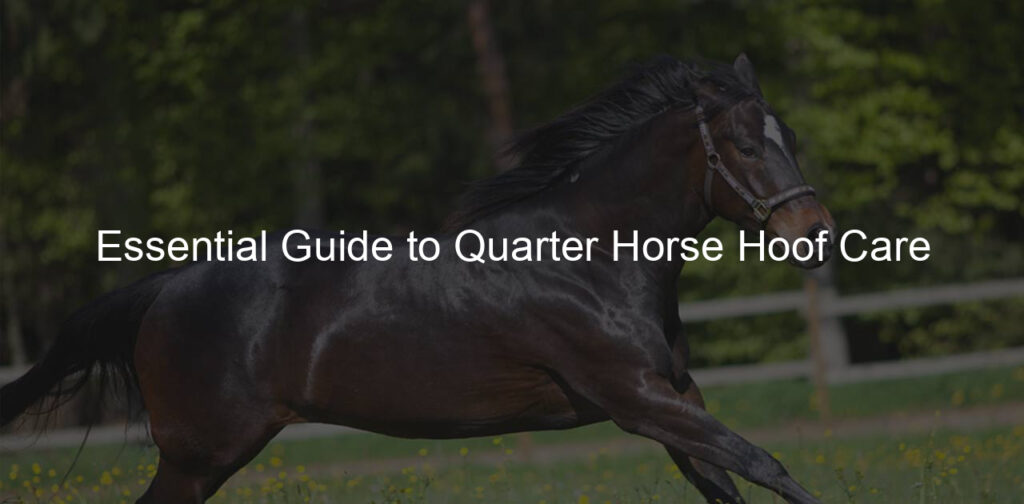Introduction to Quarter Horse Hoof Maintenance
Hey there, horse lovers! Today, we’re going to learn all about Quarter Horse hoof maintenance. It’s super important to keep our four-legged friends’ hooves healthy, and that’s especially true for Quarter Horses. So, let’s dive right in!
- Importance of equine hoof care
- Specific needs of Quarter Horses
Did you know that a horse’s hoof is a bit like our fingernails? It’s true! Just like we need to take care of our nails, horses need their hooves taken care of too. But it’s not just about looking good. Healthy hooves are key to a horse’s overall health. If a horse’s hooves aren’t cared for properly, it can lead to all sorts of problems, like lameness and infections. In fact, according to Wikipedia, about 90% of horse lameness is due to hoof problems. That’s a big deal!
Now, let’s talk about Quarter Horses. These guys are known for their speed and agility, especially in short-distance races. That means their hooves need a little extra TLC. Quarter Horses have compact, sturdy hooves that are built for speed. But that also means they’re more prone to certain conditions, like navicular disease and hoof cracks. So, it’s super important to keep an eye on your Quarter Horse’s hooves and make sure they’re getting the care they need.
So, that’s the scoop on Quarter Horse hoof maintenance. Remember, a happy horse is a horse with healthy hooves! Stay tuned for more tips on how to keep your horse’s hooves in tip-top shape.
Essentials of Horse Hoof Care
Hey there, horse lovers! Let’s dive into the fascinating world of horse hoof care. It’s super important to keep our four-legged friends’ hooves healthy and happy. So, saddle up and let’s get started!
Understanding Horse Hoof Health
Before we can take care of our horse’s hooves, we need to understand what we’re looking at. So, let’s break it down:
- Anatomy of a horse hoof
- Common hoof conditions in Quarter Horses
Did you know a horse’s hoof is a lot like our fingernails? It’s true! The outer part of the hoof, called the hoof wall, is made of the same stuff as our nails. Inside, there’s a bone (the coffin bone) and a bunch of other important stuff like the digital cushion and the laminae. It’s a complex structure that needs lots of care to stay healthy. Learn more about horse hoof anatomy here.
Quarter Horses, like all breeds, can have some hoof issues. Some common ones are hoof cracks, abscesses, and laminitis. Hoof cracks can happen if the hoof gets too dry or if the horse is working on hard surfaces. Abscesses are like pimples inside the hoof – ouch! Laminitis is a serious condition where the laminae inside the hoof get inflamed. It’s super important to catch these conditions early, so regular hoof checks are a must.
Understanding the basics of horse hoof health is the first step to keeping your Quarter Horse’s hooves in tip-top shape. Remember, a healthy hoof means a happy horse!
Hoof Care for Quarter Horses
Keeping your Quarter Horse’s hooves healthy is super important. Here are some key things to remember:
- Regular hoof inspections: Just like you need to brush your teeth every day, your horse’s hooves need regular check-ups too. Look for cracks, chips, or anything unusual. If you see something that doesn’t look right, call your vet or farrier right away. Don’t forget, prevention is better than cure!
- Proper trimming techniques: Trimming your horse’s hooves is like giving them a pedicure. It helps keep their feet in good shape and prevents problems. But remember, trimming hooves is a job for professionals. Always hire a trained farrier to do this job. They know the right way to trim without hurting your horse. Check out this Wikipedia page to learn more about farriers.
- Importance of a balanced diet: You know how your mom always tells you to eat your veggies? Well, your horse needs a balanced diet too. Good nutrition helps keep their hooves strong and healthy. Make sure your horse gets plenty of hay, grains, and fresh water. And don’t forget about vitamins and minerals. They’re super important for hoof health. Talk to your vet about the best diet for your horse.
Remember, taking care of your Quarter Horse’s hooves is a big responsibility. But with regular inspections, proper trimming, and a balanced diet, you can keep your horse’s feet in tip-top shape. Happy hoof care!
Maintaining Quarter Horse Hooves
Keeping your Quarter Horse’s hooves healthy is a crucial part of their overall well-being. Let’s delve into the world of equine podiatry to understand better how to maintain those hooves.
Equine Podiatry
Equine podiatry is a specialized field that focuses on the foot health of horses. It involves two key players: the professional farrier and the vet. Let’s learn more about their roles.
- Role of a Professional Farrier
- When to Consult a Vet
A professional farrier is like a foot doctor for horses. They’re trained to trim and balance hooves, and to fit horseshoes. Regular visits from a farrier (usually every 6-8 weeks) can help keep your Quarter Horse’s hooves in tip-top shape. They can spot problems early and provide treatments to prevent minor issues from becoming major ones.
While farriers are hoof-care experts, sometimes a vet’s expertise is needed. If your horse shows signs of severe lameness, has a hoof injury, or if the farrier notices something unusual, it’s time to call the vet. They can diagnose and treat serious conditions that are beyond the scope of a farrier’s work.
Remember, maintaining your Quarter Horse’s hooves isn’t just about regular trims and shoeing. It’s also about knowing when to call in the experts. By working together with your farrier and vet, you can ensure your horse’s hooves stay healthy and strong.
Hoof Care Techniques for Quarter Horses
Hey there, horse lovers! Let’s talk about some important hoof care techniques for our beloved Quarter Horses. These techniques are super important to keep our horses’ hooves healthy and strong.
- Proper Cleaning Methods
- Pick up the horse’s foot and hold it in your hand. Be gentle, we don’t want to hurt our horse friends!
- Use a hoof pick to remove any dirt or stones. Start at the heel and work your way towards the toe.
- Check for any signs of injury or disease, like cracks or thrush. If you see anything worrying, call your vet!
- Finally, use a brush to clean the hoof and make it shine. Remember, a clean hoof is a happy hoof!
- Shoeing Considerations
- Work with a professional farrier. They’re the experts in horse shoes and can help you make the best decision for your horse.
- Consider your horse’s comfort. If they seem uncomfortable or in pain, it might be time for a shoe change.
- Remember, shoeing isn’t a one-size-fits-all solution. Every horse is unique, so their shoeing needs might be unique too!
First things first, we gotta keep those hooves clean! Dirt and debris can get stuck in there and cause all sorts of problems. So, here’s how we do it:
Now, let’s talk about shoeing. Some Quarter Horses need shoes, while others are perfectly happy without them. It really depends on what your horse does every day. If they’re working hard on rough terrain, they might need some extra protection. But if they’re mostly hanging out in the pasture, they might be fine without shoes.
Here are some things to think about when it comes to shoeing:
And there you have it, folks! Some simple but effective hoof care techniques for our Quarter Horses. Remember, a little bit of care goes a long way in keeping our horses happy and healthy. So, grab your hoof pick and get to work!
Common Quarter Horse Hoof Conditions
Just like humans, Quarter Horses can experience a variety of hoof conditions. Knowing what to look for can help you keep your horse’s hooves healthy and strong. Let’s take a look at some of the most common conditions and how to treat them.
Identifying and Treating Hoof Conditions
Here are three common hoof conditions that Quarter Horses may experience:
- Laminitis
- Hoof Cracks
- Thrush
Laminitis is a painful condition that affects the horse’s hoof. It’s caused by inflammation in the laminae, which are the tissues that connect the hoof wall to the bone. If you notice your horse is walking funny or seems to be in pain, it might be suffering from laminitis. A vet can provide treatment, which usually involves rest, pain relief, and sometimes special shoes to help the horse walk.
Hoof cracks can occur for a variety of reasons, including dry weather, poor nutrition, or an injury. Small cracks might not be a big deal, but larger ones can cause pain and lead to infection. If you notice a crack in your horse’s hoof, it’s a good idea to have a farrier take a look. They can often repair the crack and give you tips on how to prevent them in the future.
Thrush is a bacterial infection that affects the frog of the horse’s hoof. It’s usually caused by standing in wet, dirty conditions. If your horse has thrush, you might notice a foul smell and a black, gooey substance on the bottom of the hoof. The best treatment for thrush is to clean the hoof thoroughly and apply a thrush treatment product. Keeping your horse’s environment clean can help prevent thrush.
Remember, the best way to keep your horse’s hooves healthy is regular care and maintenance. If you’re ever unsure about a hoof condition, don’t hesitate to call a vet or farrier for help.
Quarter Horse Hoof Care Tips
Hey there, horse lovers! Today, we’re going to chat about some top-notch tips for taking care of your Quarter Horse’s hooves. These tips are super important because, as we all know, healthy hooves mean a happy horse!
Preventative Measures
Prevention is always better than cure, right? So, let’s dive into some preventative measures that you can take to keep your Quarter Horse’s hooves in tip-top shape.
- Regular Exercise: Just like us, horses need regular exercise to stay healthy. Exercise improves blood circulation in the hooves, which helps keep them strong and healthy. So, make sure your horse gets plenty of trotting, galloping, and playtime!
- Proper Stable Conditions: A clean, dry stable is essential for preventing hoof problems like thrush and abscesses. Make sure to clean your horse’s stall daily and check for any sharp objects that could hurt their hooves. Also, remember to provide a dry place for your horse to stand, especially during wet weather.
Remember, a little bit of care can go a long way in keeping your Quarter Horse’s hooves healthy. So, follow these tips and your horse will thank you!
Case Study: Successful Hoof Care
- Introduction to the case
Let’s dive into the story of Dusty, a Quarter Horse who had some serious hoof problems. Dusty was a 10-year-old Quarter Horse living in a small farm in upstate New York. His owners noticed that he was limping and not as active as he used to be.
- Challenges faced
Dusty’s owners found out that he was suffering from a common hoof condition called Laminitis. This condition can cause severe pain and lameness in horses. Dusty’s case was a bit tricky because he was overweight, which made his condition worse.
- Steps taken for hoof care
First, Dusty’s diet was changed to help him lose weight. His owners also started a regular exercise routine for him. For his hooves, they called in a professional farrier who trimmed Dusty’s hooves and fitted him with special shoes to help alleviate the pain. Dusty’s owners also made sure that his stable was clean and dry to prevent further hoof problems.
- Outcome and key takeaways
After several months of proper diet, exercise, and hoof care, Dusty was back to his old self. He was no longer limping and was more active than ever. This case teaches us the importance of regular hoof care and maintenance. It also highlights the need for a proper diet and exercise in maintaining a horse’s overall health.









